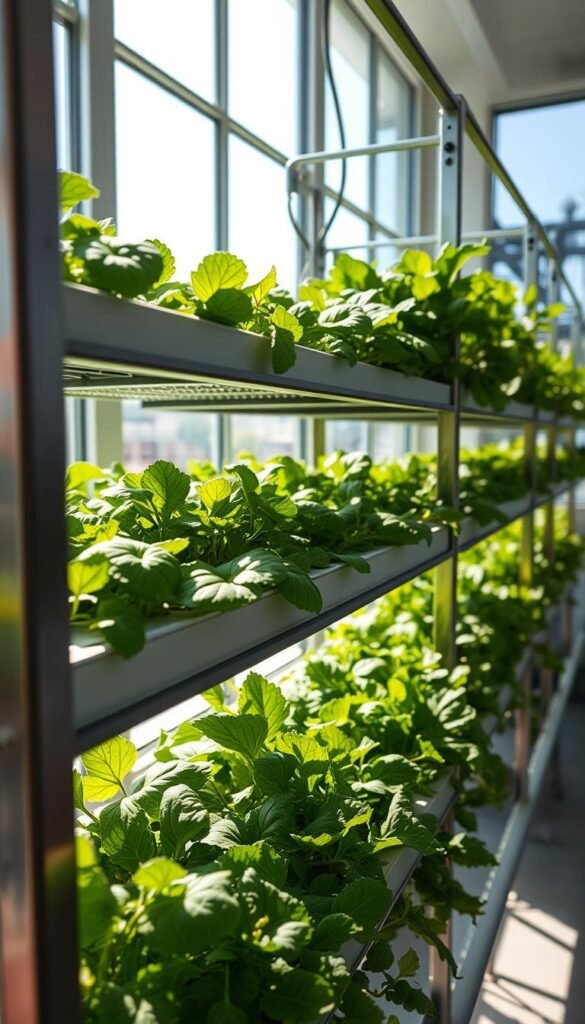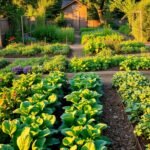When growing plants without soil, you’re faced with a choice: natural inputs or lab-formulated solutions. This decision shapes everything from crop quality to environmental impact. Let’s break down how these two approaches work and why they matter for your setup.
Soil-free farming is gaining traction as growers seek water-efficient ways to produce food. Unlike traditional agriculture, hydroponics uses precise nutrient mixes delivered directly to roots. This method reduces pesticide reliance and accelerates growth cycles, making it ideal for urban spaces or regions with poor soil.
Refined nutrient solutions let you customize plant diets for higher yields. Controlled environments minimize weather risks while recycling up to 90% of water. These systems also slash pest invasions, meaning healthier crops year-round.
But how do natural and synthetic options compare? We’ll explore costs, setup complexity, and long-term sustainability. Whether you’re a hobbyist or commercial grower, understanding these differences helps you maximize efficiency without compromising your goals.
Key Takeaways
- Hydroponic systems use 90% less water than soil-based farming.
- Custom nutrient blends can boost crop yields by up to 30%.
- Controlled environments reduce pesticide needs by limiting pests.
- Natural inputs support sustainability but may require more maintenance.
- Synthetic solutions offer consistency but raise questions about long-term soil health.
- Urban growers benefit from compact vertical setups in limited spaces.
Understanding Hydroponics: A Modern Farming Approach
Imagine growing lettuce on your apartment balcony or fresh herbs in a repurposed shipping container. This isn’t sci-fi—it’s hydroponics. The method traces back to ancient Greek “water working” (hydro + ponos), but today’s tech lets you skip soil entirely. Roots soak up custom blends of minerals dissolved in water, creating a buffet for your greens.

Defining Hydroponics and Its Origins
Hydroponics isn’t new—Babylon’s Hanging Gardens likely used early versions. Modern systems let you control every bite your plants take. Instead of digging through dirt for food, crops get precise nutrient solutions pumped to their roots. This direct feeding speeds up growth cycles by 25-50% compared to traditional farming.
How Hydroponics Differs from Traditional Farming
Forget waiting for rain or fighting weeds. Your setup uses 90% less water than soil-based fields because it recirculates every drop. Vertical towers grow 3x more kale per square foot, perfect for city spaces. Automated dosers add exact amounts of nitrogen and potassium, eliminating guesswork.
| Feature | Hydroponics | Soil Farming |
|---|---|---|
| Space Needed | 10 sq ft for 30 plants | 100 sq ft for 30 plants |
| Water Use | 1 gallon daily | 10 gallons daily |
| Nutrient Control | Exact pH-adjusted mixes | Soil-dependent |
Active systems like NFT channels keep roots bathed in flowing solutions, while passive wick setups work for small herbs. Either way, you’re growing food where concrete once ruled—no tractors required. Urban growers from Detroit to Phoenix are turning rooftops into tomato jungles, proving soil’s optional for fresh produce.
The Key Benefits of Hydroponic Systems
Growing plants faster while using less space isn’t magic—it’s hydroponics. These setups let you bypass nature’s limitations through smart design and precise resource management. Here’s how they outperform dirt-based methods in three critical areas.
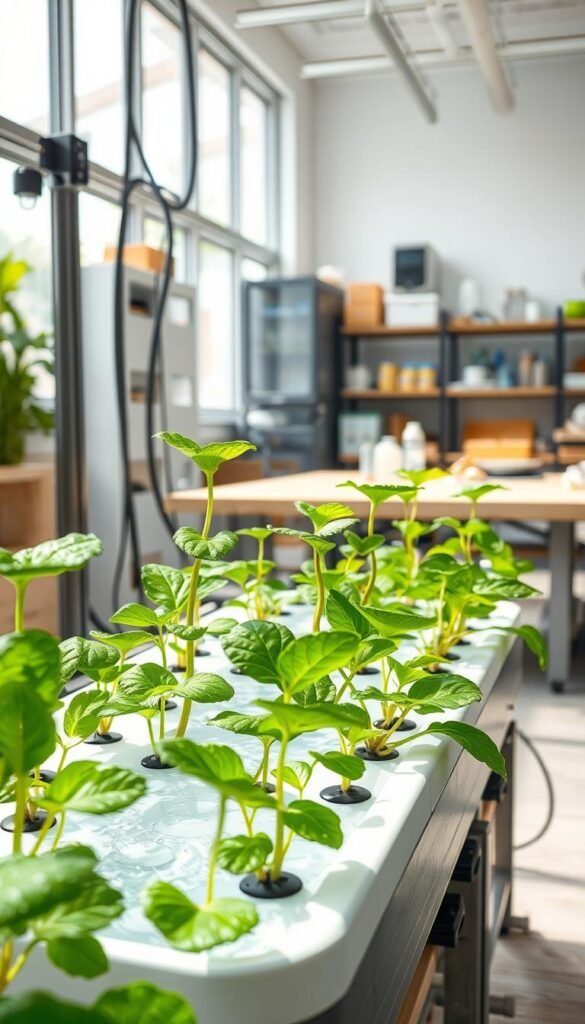
Enhanced Efficiency and Year-Round Production
Your crops don’t care if it’s snowing outside. Closed environments maintain perfect temperatures and light levels 365 days a year. LED grow lights mimic summer sun in winter, while automated timers deliver nutrient-rich solutions exactly when roots need them.
This control slashes growth cycles by weeks. Leafy greens like spinach mature 30% faster compared to soil farming. You’ll harvest basil every 28 days instead of 45—no waiting for seasons to change.
Water Conservation and Space Optimization
Traditional fields lose 70% of water to evaporation and runoff. Hydroponics reuses every drop through closed-loop systems. A single gallon grows 6x more lettuce than soil methods. Vertical racks stack plants upward, letting 10 sq ft produce what once required 100.
- Recirculating pumps cut water use by 90%
- Tower gardens yield 3x more kale per square foot
- Root misting eliminates fertilizer waste
Urban growers from Brooklyn rooftops to Denver basements prove space isn’t a barrier. You control the environment—not the weather—making every inch count toward fresher, pesticide-free food.
Organic vs. Conventional Hydroponic Methods: Pros & Cons
Choosing how to nourish your plants reveals critical trade-offs between precision and sustainability. Let’s explore how different feeding strategies affect your harvest’s quality and your wallet.
Nutrient Management and Crop Quality
Hydroponic systems deliver restaurant-quality meals to plant roots. Instead of guessing soil composition, you mix exact mineral ratios in water—like a chef crafting perfect broth. This precision eliminates nutrient deficiencies that plague traditional composting methods.
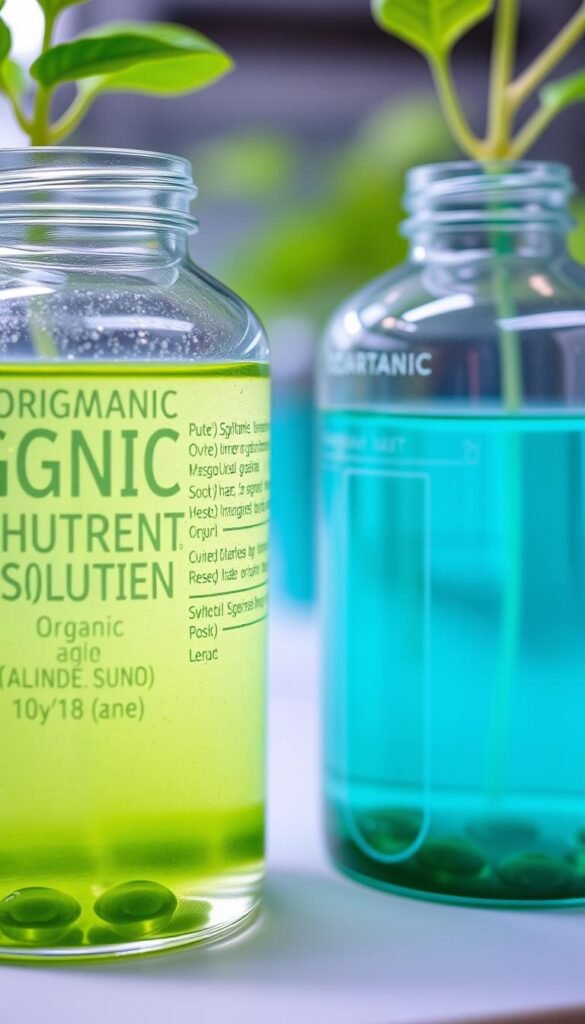
Controlled environments let you adjust conditions hourly. Kale grown under optimized lights develops 15% more antioxidants than field varieties. Growee’s automated systems in Colorado greenhouses show 22% larger strawberry yields with zero pesticide residues.
Cost Implications and Investment Considerations
Starting a high-tech setup demands upfront spending. Commercial growers report $15,000-$50,000 initial costs for climate controls and monitoring gear. But savings add up:
- 30% less fertilizer waste compared to soil farming
- Automated dosing cuts labor by 40%
- Year-round production triples annual harvests
Traditional methods require constant soil amendments and more space. One Arizona farm reduced water bills by 78% after switching to recirculating hydroponics—proof that smart investments pay off.
| Factor | Soil-Based | Hydroponic |
|---|---|---|
| Annual Yield | 5 lbs/sq ft | 18 lbs/sq ft |
| Startup Cost | $2,000 | $12,000 |
| Labor Hours | 20/week | 8/week |
Whether you prioritize immediate savings or long-term efficiency shapes your approach. Test small-scale setups before committing—your perfect balance awaits.
Environmental Impact and Resource Management
Growing food sustainably means tackling water waste and energy use head-on. Hydroponic setups shine here, offering clever ways to protect ecosystems while feeding communities. Let’s explore how these systems balance environmental care with reliable harvests.
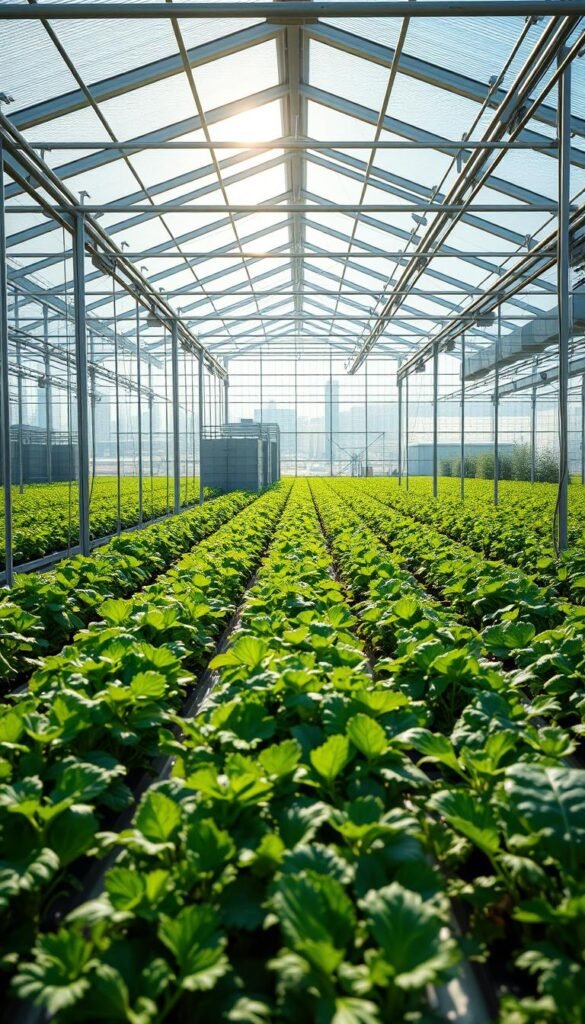
Sustainable Water Usage and Reduced Pollution
Traditional farms lose gallons to evaporation and runoff. Your hydroponic system reuses 90% of water by cycling nutrient-rich solutions through plant roots repeatedly. Closed-loop designs prevent fertilizer spills that contaminate rivers—a common issue with soil-based growing.
Soil degradation vanishes since no tilling occurs. Growers in Arizona reduced nitrate pollution by 68% after switching to water-based methods. You’ll also avoid pesticides that harm pollinators, creating cleaner ecosystems around your operation.
Energy Consumption and Climate Proofing
Indoor setups need lights and climate controls, but solar panels now power many farms. BrightFarms in California runs entirely on renewable energy, cutting carbon emissions by 40% yearly. Smart sensors adjust temperatures automatically, saving power during off-peak hours.
Harsh weather? No problem. Your crops thrive in sealed environments while droughts or floods ravage outdoor fields. Vertical farms in Texas maintained 100% production during recent heatwaves—proof that climate-proofing works.
| Factor | Hydroponic Farming | Traditional Farming |
|---|---|---|
| Water Usage | 1-2 gallons/day | 10+ gallons/day |
| Energy Source | 40% solar/wind | 5% renewable |
| Pollution Risk | Low | High |
| Production Consistency | Weather-proof | Seasonal |
Future systems might harvest rainwater or use geothermal energy, pushing sustainability further. As tech advances, you’ll grow more with less—keeping plates full and planets healthy.
Innovative Hydroponic Technologies for Optimal Growth
Smart tech is rewriting the rules of dirt-free farming. Today’s systems think for you, adjusting conditions in real-time while cutting busywork. Let’s explore how these breakthroughs help your greens thrive with less effort.

Automation and Remote Monitoring Solutions
Imagine your phone buzzing when basil needs more potassium. Systems like Growee Hydroponics Automation do exactly that. Sensors track pH levels and nutrient strength 24/7, sending alerts before problems arise.
Automated dosers mix precise fertilizer ratios into water reservoirs. No more manual measuring—just set your recipe and watch pumps deliver perfect meals to roots. Growers report 18% fewer errors compared to hand-mixed solutions.
Advances in Nutrient Solutions and Fertilizer Efficiency
New formulas feed plants smarter, not harder. Time-release minerals maintain ideal concentrations for weeks, while enzyme boosters help roots absorb 40% more iron and calcium. Trials show lettuce matures 5 days faster with these enhanced blends.
Cloud-based dashboards track your crop’s history through colorful trend graphs. Spot patterns like “peppers need less nitrogen at night” and tweak schedules instantly. One Colorado farm cut labor by 35 hours weekly using these tools.
“Our automated system grows 2,000 heads of kale monthly with just 3 hours of maintenance.”
These innovations let you focus on scaling up, not micromanaging. Whether running a backyard setup or commercial operation, smart tech keeps your plants happy while your schedule stays free.
Challenges and Considerations for Hydroponic Growers
Every farming method has its hurdles, and soil-free setups are no exception. While you’ll enjoy faster growth and space savings, certain obstacles require careful planning to overcome.
Startup Costs That Make You Think Twice
Setting up requires more cash than traditional gardening. Commercial systems often demand $10,000+ for climate controls, grow lights, and monitoring tech. Even home kits cost $300-$1,500 upfront—10x more than soil-based starters.
| Expense Type | Home Setup | Commercial Farm |
|---|---|---|
| Lighting | $150-$500 | $5,000-$20,000 |
| Nutrient Systems | $80/month | $1,200/month |
| Monitoring Gear | Optional | $3,000+ |
Daily Demands and Hidden Risks
Your plants need constant attention. Power outages can kill crops in hours if backup generators fail. One Colorado grower lost 400 lettuce heads during a winter storm when pumps froze.
Waterborne pathogens spread fast in closed systems. Weekly pH checks and sterilizing roots become non-negotiable. UrbanLeaf Farms in Detroit trains staff for 40 hours before letting them touch the nutrient mixers.
But smart planning pays off. Brooklyn’s GreenSky Gardens uses solar batteries and dual pumps as insurance. They’ve maintained 95% crop survival rates for three years straight—proof that preparation beats problems.
Comparing Hydroponic and Traditional Farming Practices
Picture your favorite vegetables growing in a space no bigger than your closet. That’s the reality of modern farming methods—where soil-free setups challenge centuries-old agricultural norms. Let’s explore how these approaches differ in space use, environmental effects, and long-term viability.
Space Efficiency vs. Land Requirements
Hydroponic setups stack plants vertically, turning 100 sq ft into 300 sq ft of growing area. You’ll grow 10x more basil in a tower system than in traditional rows. Meanwhile, soil-based farms need expansive fields—often cleared through deforestation—to match output.
- Vertical farms produce 20 lbs/sq ft annually vs. 5 lbs/sq ft in soil
- Commercial growers in Chicago report 80% less land use with hydroponics
- Traditional methods require 3 acres to match 1 hydroponic acre’s yield
Soil Dependency and Environmental Impacts
Dirt-free systems skip soil entirely, eliminating erosion risks and disease spread. Your plants drink 90% less water while avoiding pesticide runoff that pollutes rivers. But traditional fields still dominate for crops like wheat and corn—plants needing deep root systems.
| Factor | Hydroponic | Traditional |
|---|---|---|
| Water Use | 2 gal/day | 20 gal/day |
| Land Needed | Compact | Expansive |
| Soil Health | Not applicable | Degrades over time |
Urban growers favor compact systems for fresh herbs and leafy greens. Yet sprawling farms remain essential for grains and root vegetables. Your choice depends on what you grow—and how much earth you’re willing to spare.
Future of Farming: Sustainable Solutions in Hydroponics
Tomorrow’s dinner plate might come from a skyscraper farm downtown. Urban spaces are transforming into food hubs as growers embrace soil-free systems. These solutions tackle climate challenges while feeding growing cities.
Adoption Trends Among Urban and Commercial Growers
City-based farms increased by 42% last year according to USDA reports. Vertical setups in warehouses now supply 15% of New York’s leafy greens. You’ll find these systems in schools, hospitals, and even grocery store basements.
| City | Farms (2023) | Annual Yield (lbs) |
|---|---|---|
| Chicago | 87 | 2.1 million |
| Los Angeles | 112 | 3.8 million |
| Miami | 64 | 1.5 million |
Companies like Gotham Greens use AI-powered sensors to track plant health. Their Brooklyn facility grows 10x more basil per square foot than traditional greenhouses.
Innovative Practices Shaping Food Production
Automation cuts labor costs while boosting precision. Smart systems adjust nutrient mixes based on real-time root analysis. One Colorado farm reduced fertilizer waste by 55% using this tech.
“Our solar-powered hydroponic rigs grow 500 lbs of kale weekly—no grid electricity needed.”
Closed-loop water systems and biodegradable grow mats now slash environmental impacts. These advances make initial investments pay off faster—some setups break even in 18 months.
Conclusion
Your farming journey hinges on balancing precision with sustainability. Natural and synthetic approaches each offer distinct advantages—natural options support eco-friendly practices, while lab-made solutions deliver consistent results. Both methods let you grow robust crops without soil, using up to 90% less water than traditional techniques.
Automated systems simplify nutrient delivery, ensuring your plants get exact mineral ratios for optimal growth. These innovations slash labor costs and reduce fertilizer waste by 30-40%. Urban growers particularly benefit from compact setups that yield fresh produce year-round in limited spaces.
Consider upfront costs against long-term savings. While advanced equipment requires significant initial investment, efficient water recycling and higher crop density pay off over time. Future-focused solutions like solar-powered rigs and smart sensors make this approach increasingly accessible.
As cities expand, these soil-free systems will play a vital role in feeding communities sustainably. Whether you prioritize environmental impact or crop consistency, your choice shapes tomorrow’s food landscape. Explore hybrid models that blend the best of both worlds—your perfect harvest strategy awaits.
